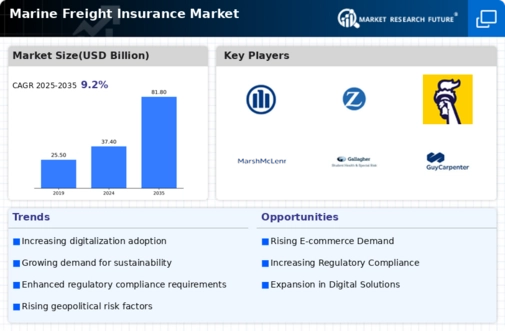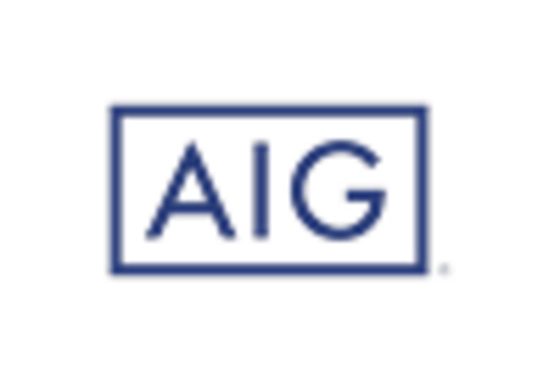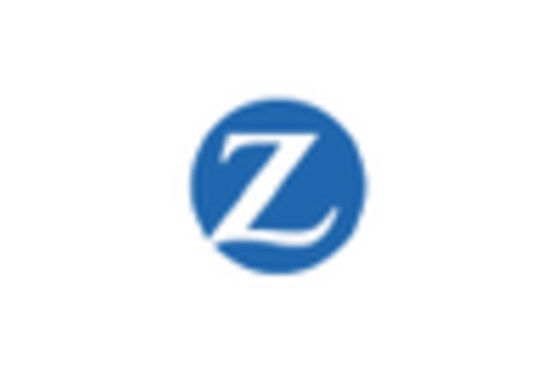Increasing Trade Volumes
The Marine Freight Insurance Market is experiencing a notable surge in trade volumes, driven by the expansion of international trade agreements and the growing demand for goods across various sectors. As countries engage in more trade, the need for reliable marine freight insurance becomes paramount. In 2025, the total volume of goods transported by sea is projected to reach approximately 12 billion tons, indicating a robust growth trajectory. This increase in trade activities necessitates comprehensive insurance solutions to mitigate risks associated with cargo loss, damage, and liability. Consequently, the Marine Freight Insurance Market is likely to witness heightened demand as businesses seek to protect their assets during transit, ensuring that they are adequately covered against potential disruptions.
Technological Advancements
Technological advancements are reshaping the Marine Freight Insurance Market, enhancing operational efficiency and risk assessment capabilities. The integration of digital platforms and data analytics allows insurers to better evaluate risks associated with marine transport. For instance, the use of blockchain technology is gaining traction, providing transparency and traceability in shipping transactions. This innovation not only streamlines the claims process but also reduces fraud, thereby fostering trust among stakeholders. Furthermore, the adoption of IoT devices enables real-time monitoring of cargo conditions, allowing insurers to respond promptly to any incidents. As these technologies continue to evolve, they are expected to play a crucial role in driving the Marine Freight Insurance Market forward, potentially increasing the overall market size by an estimated 15% over the next five years.
Emerging Markets and Trade Routes
Emerging markets and new trade routes are presenting fresh opportunities for the Marine Freight Insurance Market. As economies in Asia, Africa, and Latin America continue to develop, they are becoming increasingly integrated into global supply chains. This integration is leading to the establishment of new shipping routes, which in turn creates a demand for marine freight insurance to cover the associated risks. For example, the Belt and Road Initiative is expected to enhance trade connectivity, resulting in increased shipping activities in these regions. As a result, the Marine Freight Insurance Market is likely to expand its offerings to cater to the unique challenges posed by these emerging markets. Insurers may need to develop specialized products that address the specific risks associated with these new trade routes, thereby fostering growth in the industry.
Regulatory Changes and Compliance
The Marine Freight Insurance Market is significantly influenced by regulatory changes and compliance requirements imposed by various maritime authorities. As governments implement stricter regulations to enhance safety and environmental standards, businesses are compelled to adapt their operations accordingly. Compliance with these regulations often necessitates obtaining adequate insurance coverage to protect against potential liabilities. For instance, the International Maritime Organization has introduced new guidelines aimed at reducing emissions from shipping, which may require companies to reassess their insurance needs. This evolving regulatory landscape is likely to drive demand for marine freight insurance, as businesses seek to ensure compliance while safeguarding their interests. Consequently, the Marine Freight Insurance Market may experience growth as insurers develop products that align with these regulatory requirements.
Rising Awareness of Risk Management
There is a growing awareness of risk management among businesses engaged in maritime trade, which is significantly influencing the Marine Freight Insurance Market. Companies are increasingly recognizing the potential financial repercussions of cargo loss or damage, prompting them to invest in comprehensive insurance solutions. In 2025, it is estimated that the marine insurance sector will account for approximately 30% of the total insurance market, reflecting a shift in focus towards safeguarding assets. This heightened awareness is likely to drive demand for tailored insurance products that address specific risks associated with different types of cargo and shipping routes. As businesses prioritize risk mitigation strategies, the Marine Freight Insurance Market is expected to expand, offering innovative solutions to meet the evolving needs of clients.

















Leave a Comment